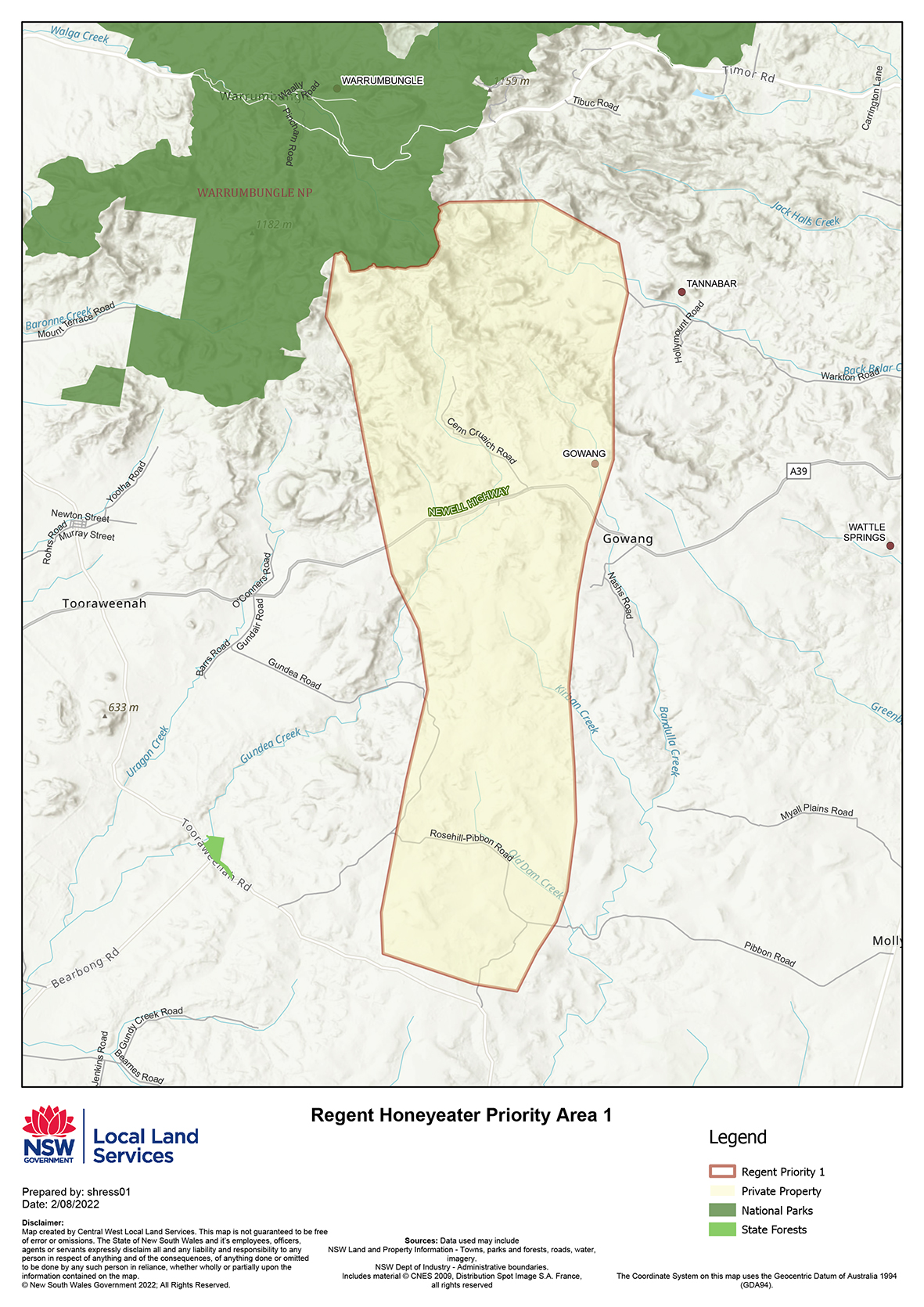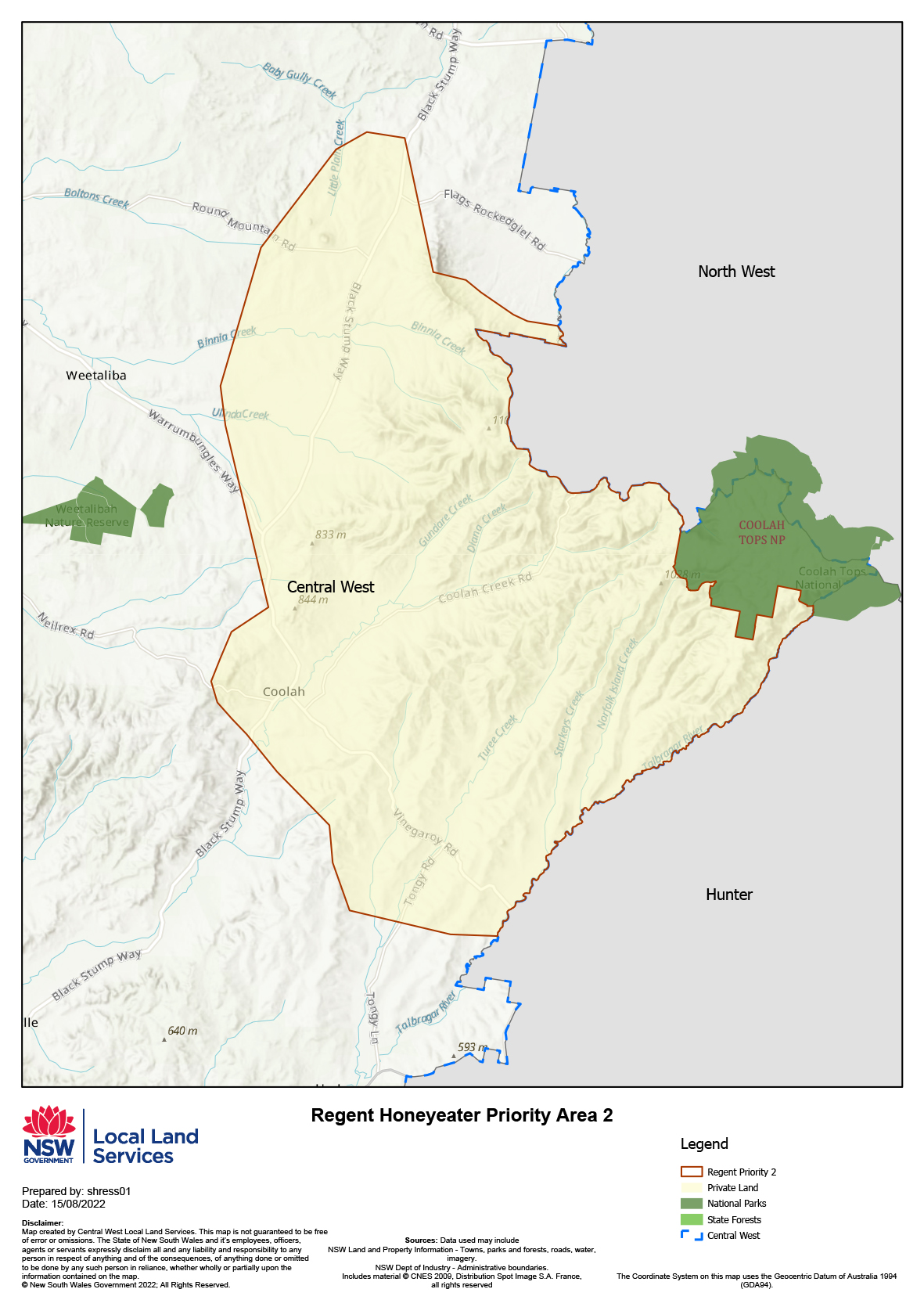Regent honeyeater
Overview
The Central West Local Land Services region contains important habitat for the critically endangered Regent Honeyeater. The bird had previously occupied much of eastern Australian woodlands, but the species has declined to around 350-400 birds left in the wild. The Regent Honeyeater has been seen at a few locations within the Central West region and with important breeding grounds in proximity it is important that we preserve key habitat areas so that passing birds can rest, drink and forage.
The Reaching out to the Regent Honeyeater project aims to increase community awareness about the species, monitor areas of known and potential habitat and carry out on ground works to preserve and restore habitat and corridors in priority areas. The focus of this project is for works to occur in areas with mature Mugga Ironbark, White Box, Yellow Box woodlands and River She-oak as these species provide a critical food source for nomadic birds. Along with these trees, they also seek out flowering mistletoe, in particular Box Mistletoe in box and ironbark woodlands, and Needle-leaf Mistletoe in River She-oak.
Ongoing protection, management and recovery of remnants on private land is crucial to the future survival of this unique species. Priority areas have been identified across the central west region with recommended activities to support and increase the connectivity and condition of significant habitat.
Applications close on October 7, 2022.
Project information sheet
- Regent Honeyeater (Priority Area 1) information sheet (PDF)
- Regent Honeyeater (Priority Area 2) information sheet (PDF)
Priority area maps
 |  |
|---|
What type of activities may be funded?
The Healthy Landscapes - Regent Honeyeater program will provide funding and technical support for the following activities, subject to site assessment and project ranking:
Activity | Description | Dollar amount |
Stock-proof fencing | Fencing to control grazing, allowing regeneration to occur and improving groundcover. Boundary Fencing is ineligible for funding. | $6,000/km conventional or $3,000/km electric. |
Alternate water supply | Alternate watering points will be available if an existing watering point is lost due to the project. | $1,500/trough, $3,000 tank and trough or dam capped at $9,000 per project. |
Supplementary planting | Supplementary planting of native trees and shrubs to extend and improve an existing remnant area or to connect patches of vegetation. | Up to $1,000 per project to support site preparation, planting and maintenance for direct seeding or planting of tubestock. |
Pest animal and pest plant control | Pest plant and animal control in the project area. | Up to $50/ha capped at $1,500 per project. |
Cultural heritage site assessment | Cultural site identification prior to on-ground works will ensure project activities will not cause damage to Aboriginal cultural sites. | Arranged by Local Land Services at no cost to the landholder. |
Training and resources | Free information resources and workshops will be available to assist in the completion of the project and ongoing management. |
Eligibility
To be eligible for funding, landholders must meet the following criteria:
- The project area must be located within the Central West Local Land Services region and within the targeted priority area, see Map 1 and 2 with and one/all the priority tree species Mugga Ironbark, White Box, Yellow Box and River She-oak are present within the project site as these species They provide critical food sources for the Regent Honeyeater.
- The fence must be stock-proof and maintained in a stock-proof condition for the duration of the 10-year agreement.
- Troughs must at a minimum be concrete with a fully enclosed valve chamber and must be maintained in operational condition for the life of the project.
- The applicant must comply with the project standards (see following pages).
- The applicant must have $10 million public liability insurance.
- Non-payment of rates and other Local Land Services fees and accounts will result in application ineligibility.
- All project infrastructure works must be completed by 30 April 2023.
How to apply
Applications closed October 7, 2022 and will be assessed in the order they are received. To apply, complete an Expression of Interest form and submit:
- In person: hand deliver to any Central West Local Land Services office.
- Via email: submit as a PDF attachment to: incentives.centralwest@lls.nsw.gov.au
Assessment process
- Once all details have been completed, and the application form returned, a Central West Local Land Services officer will contact you to discuss your project and organise a site visit. Any incomplete applications will be returned to the landholder.
- Funding availability is limited and offered based on a Central West Local Land Services team review of the environmental services ratio scores and cost per hectare of all proposals.
- Applications received after the closing date will not be considered.
Contact
Libby McIntyre | Acting Senior Land Services Officer - NRM
PO Box 1048 | 209 Cobra Street | Dubbo NSW 2830
M: 0429 019 309 E: libby.mcintyre@lls.nsw.gov.au
Disclaimer: Funding is limited, which may mean some incentive projects will not be funded. Central West Local Land Services reserves the right to refuse funding for incentive projects or components which provide insufficient environmental benefit for their cost. Assessment of environmental benefit is at the sole discretion of the Central West Local Land Services. Funding amounts listed are GST exclusive. Funding amounts, activities and project standards are subject to change without notice.